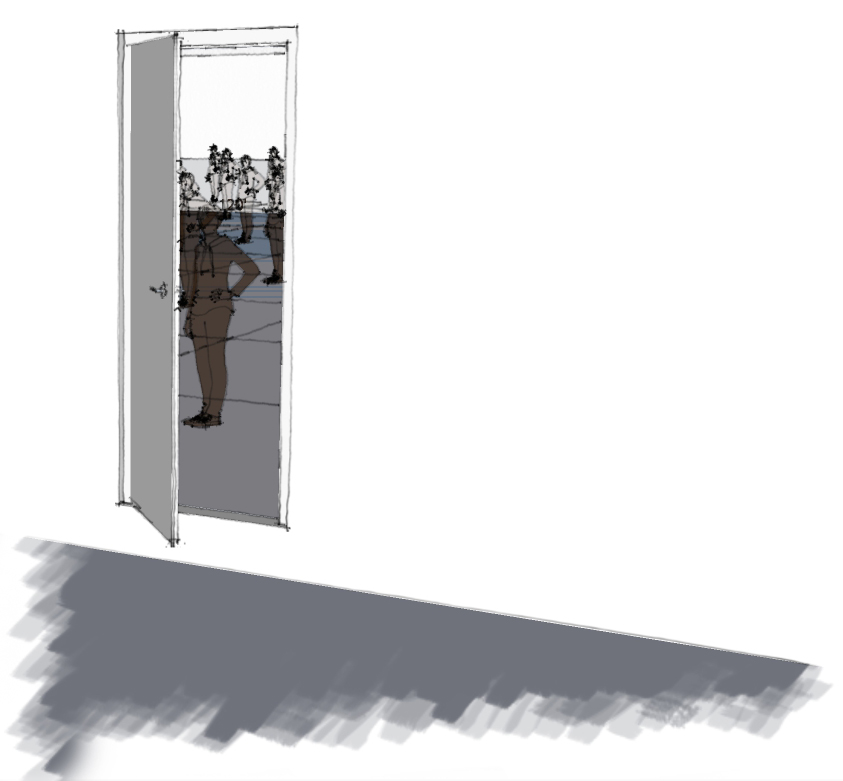
by Jeff Serbin | Jul 17, 2018 | ADA, architect in Arizona, Blog, building code, door, Interiors, office architecture, office design arizona
As an Architect, I interact with clients, engineers and contractors who have acquired bits of information about Building Codes. Sometimes, those bits are misconceptions and regurgitated information. The building codes can be intimidating and have no beginning or end. To learn the code, the best way is jumping in feet first.
Upcoming Blog Posts
In the next series of blog posts, I will explore common simple and more complex Building Codes. Each City has adopted a code but most in Arizona use the IBC (International Building Code).
The issues to be addressed in the following Blog Posts are:
- Door swing direction. Which way should the door swing, out of a room or in?
- Number of exits within a room?
- Size of the door. Who said “size doesn’t matter.”
- Exit corridor width. How wide or narrow can a hallway be?
- Clearances around a door? Door arrangement between two doors.
- Door fire ratings. Is your door fire rated?
- Exit Travel Distance.
- Do I need an Elevator?
- Should my door have panic hardware?
- Do I need a drinking Fountain?
- Minimum size of a single person toilet room?
- Small commercial space, is one bathroom enough?
The item in bold to be addressed in this post. As an Arizona Architect, most City’s jurisdictions work with the IBC (International Building Code). The code analysis is based upon the IBC.
Door Swing Direction
A buildings exit pathway typically consists of and exit pathway with hallways containing doors from offices, restrooms, mechanical rooms, leading to the exterior. In certain scenarios, the doors can swing either in or out. In some cases, functionality within the space dictates a swing direction unless code overrides. Below is a graphic showing door swing IN versus OUT.

There are sliding doors, roll up doors, revolving doors, however ‘most’ of those do not meet code requirements. I say ‘most’ because there are some exceptions and some manufacturers who have come up with creative solutions around this issue. Note in the graphic above, the door swinging out or into the hallway would block circulation. There is code requirements for clear hallway width, which will be discussed in upcoming blog posts. In this scenario, swinging into the office was preferable. Each office was small enough to allow doors to swing in.
Hinged (swinging) doors required unless:
- Private garages, office areas, factory and storage areas with an occupant load of 10 or less.
- Group I-3 Occupancies used as a place of detention
- Critical or intensive care patient rooms within suits of health care facilities
- Doors serving single dwelling unit (apartments/child care) under specific occupancy count (see code)
- Doors serving a bathroom in Occ. R-1 (residential)
- etc. The code goes into more details with exceptions
The factors which typically dictate the direction of the door swing are as follows:
- Number of occupants.
- Type of Occupancy
- Hazardous condition of room
Number of occupants is determined by Occupancy type. For instance, the code has a table which calculates the number of occupants per s.f. For example, an office space of 4,000 s.f. would have an occupant load of 4000/100 or 40 occupants. See example below.
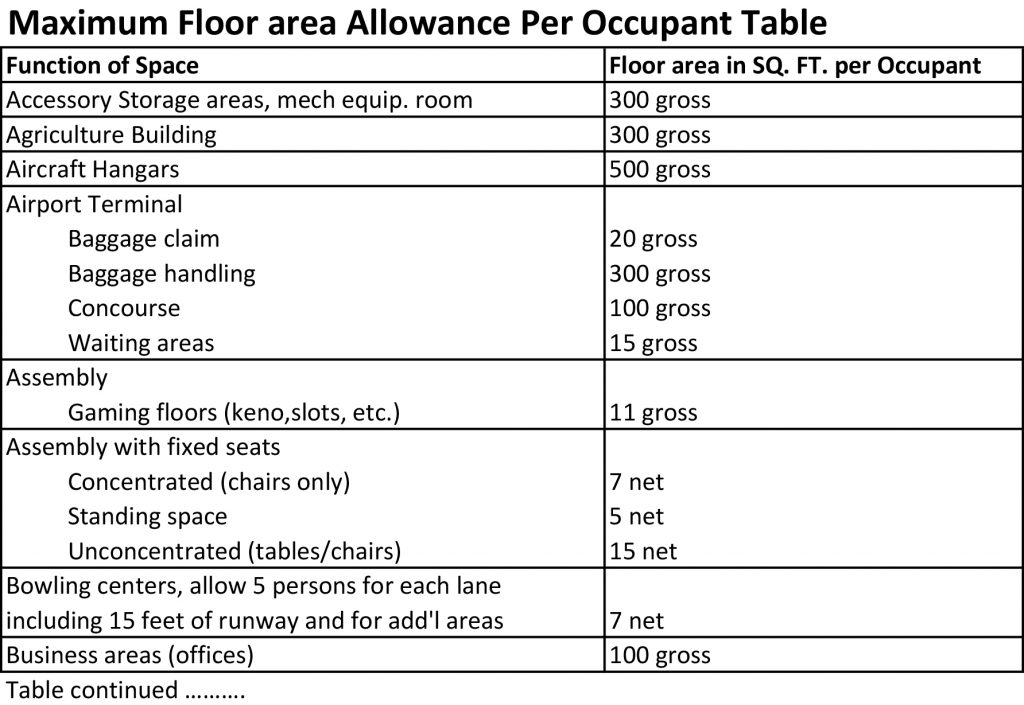
When occupant load is 50 or greater, doors shall swing in direction of travel or ‘out’.
Office Scenario
In the example below, each office may have less than 50 occupants. Those individual office doors swing in. The accumulation of all office occupants however exceeds 50 occupants. The door out of the general office area to the main exit corridor (in dark red) would need to swing ‘out’.
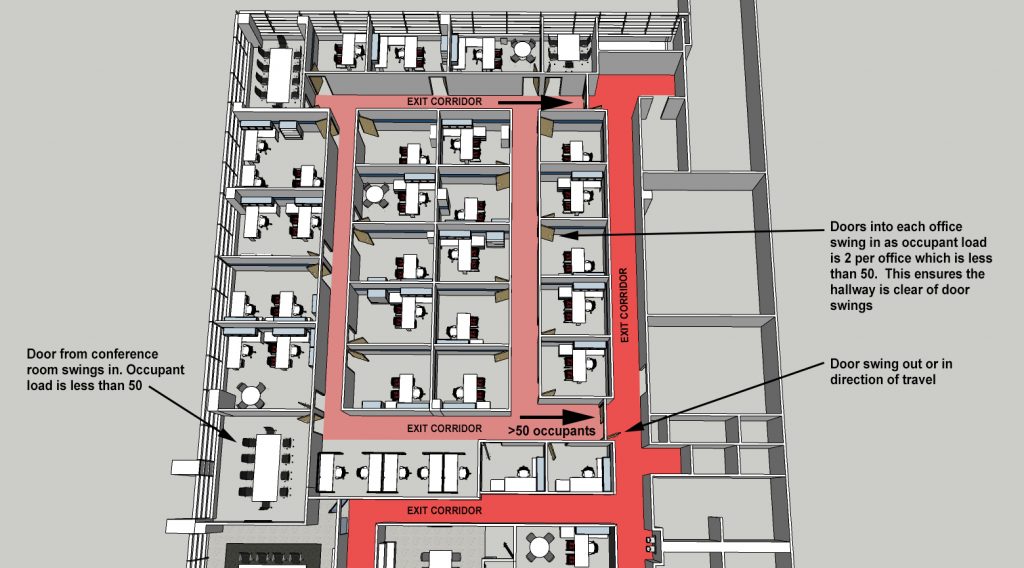
Other factors such as hazardous conditions can dictate the swing of a door. For example, within an electrical room, when the overall power exceeds 1200A, doors must swing in direction of travel.
Summary
What is the reasoning for swinging doors in the direction of travel in larger occupant loads or hazardous conditions? Imagine you are at an event with over 50 people and an emergency occurs, such as a fire. If you are the first person to reach the door and all 50 people rush in panic to the exit door at the same time, it would be difficult to swing the door towards yourself. Everyone would be pushing to move forward and out of the space. Therefore, swinging out would be easier to open. The code is created, reviewed and modified from years of learning from past mistakes.
When learning building codes, once you begin digging into the code, it begins to make sense. In regards to door swing, swinging in the direction of travel or outward will work for all conditions in the code. However when it is not required, such as in a small office, storage room or bedroom, functionally it may make sense to swing into the room. Look at how many occupants are within the room and determine if the room is a hazardous condition. When in doubt, rely on an Arizona Architect to explore the code and assist you.
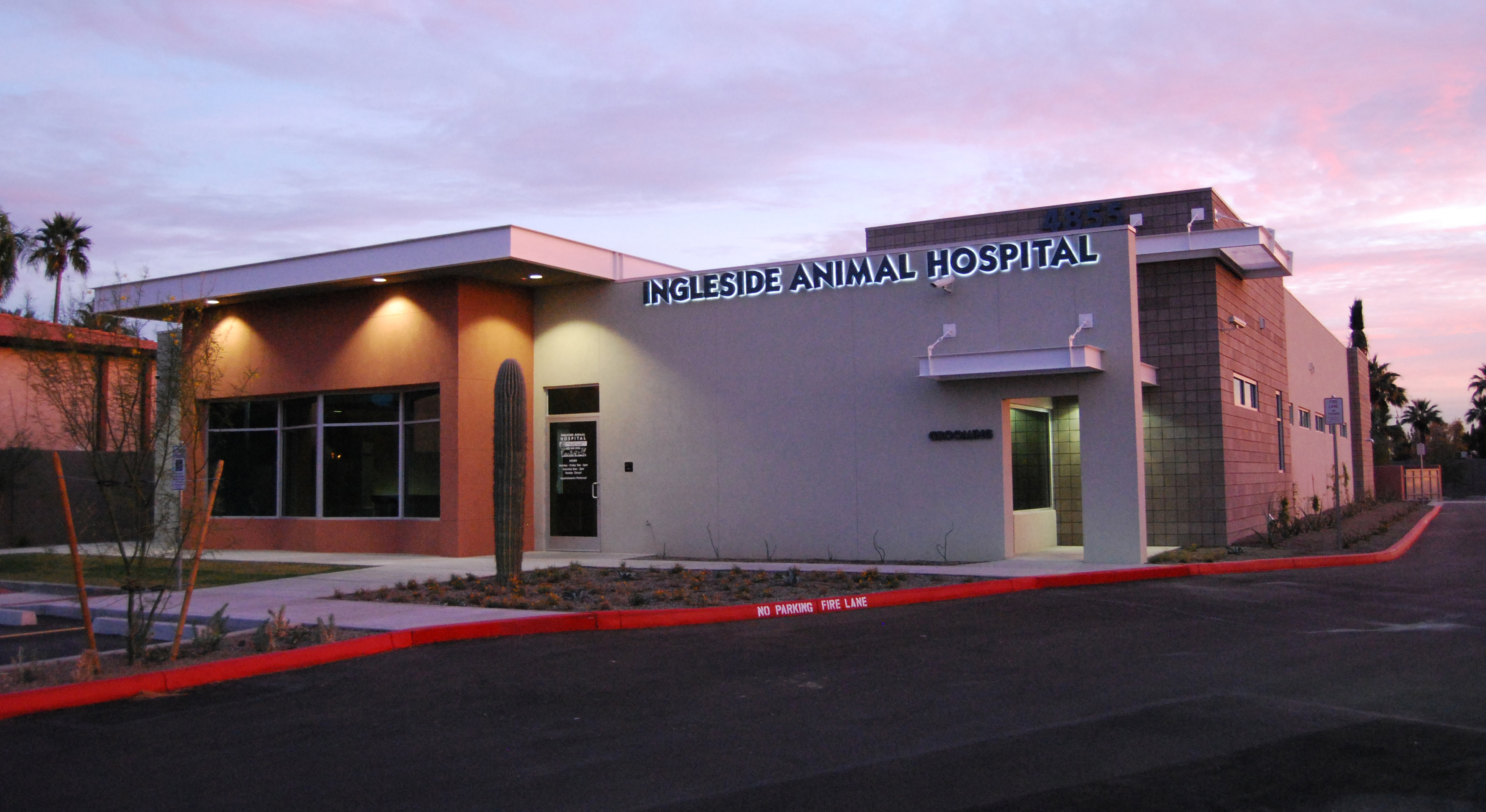
by Jeff Serbin | Jul 13, 2018 | Architectural Planning, Architecture, Blog, phoenix architects, Planning, Uncategorized
Animal Hospital Design in Arizona
Building a new Animal Hospital Design in Arizona, a Grooming Facility or boarding facility is a humbling and exciting endeavor. The most important part of the process is to put together a qualified team to tackle the project. The team may comprise of the following:
- Architect
- Accountant
- Banker
- Construction Manager
Where do you begin? First start with the dream and visualize what the facility may comprise of. If its a Hospital, how many exam rooms or surgical tables do you desire? Will the facility include grooming? Boarding animals overnight? Boarding cats, dogs or other types of animals? Will the building be for small or large animals? Many of these questions should be asked, but as part of the dreaming, a budget needs to be blended into the dreams so the project is practical.
Planning
The project will not be simply putting a drawing together, getting an estimate, financing and constructing the building. You will spend time working with the team to come up with the details, specifics for the layout of the building and the type of equipment you desire to function properly. Are you looking at an existing building and doing a tenant improvement or will you be creating a new building? The process can take months and possibly years to see completion, depending on the steps required to create your dream facility.
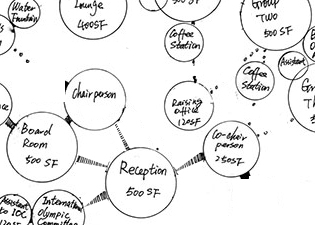
Programming Bubble Diagram
Hiring an architect with veterinary experience certainly makes the project easier. An architect can provide you with examples and guidelines that address many concerns from size of rooms, workroom flow within the facility, options in materials and code requirements. The architect can take a look at an existing building and create floor plan options to explore the best us of the space. When building a new building, floor plan options can explore the site for the best building approach, best solar orientation, best use of the parking for unloading of the pets and understanding the zoning requirements.
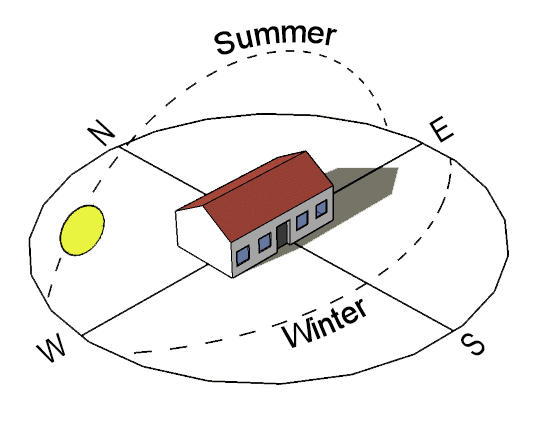
Solar orientation
When financing a project, going to the lender or bank with only a dream vision is typically not enough. The architect can take your dream and take the ideas in words and create the conceptual plans that allow a contractor to determine an estimated construction cost. The lender will typically need a conceptual drawing, estimated construction cost and your business plan. This information will give a good impression to the lendor, that you have a good plan for your new endeavour.
Construction
Once the design has been completed, the contractor has been selected, the building permits and other approvals are obtained and the financing has been established, the exciting part is watching the facility become a reality. All the time and effort finally begins to pay off. Your involvement is not finished as we strongly recommend your involvement during the construction. During the construction phase, there are many decisions that need to be made. The architect role should be overseeing the contractors construction to ensure they are using the correct finishes and equipment as specified in the drawings. Your involvement should include the finishing touches, such as final approval of finishes, selection of furnishings and final walk through to ensure the project completion.
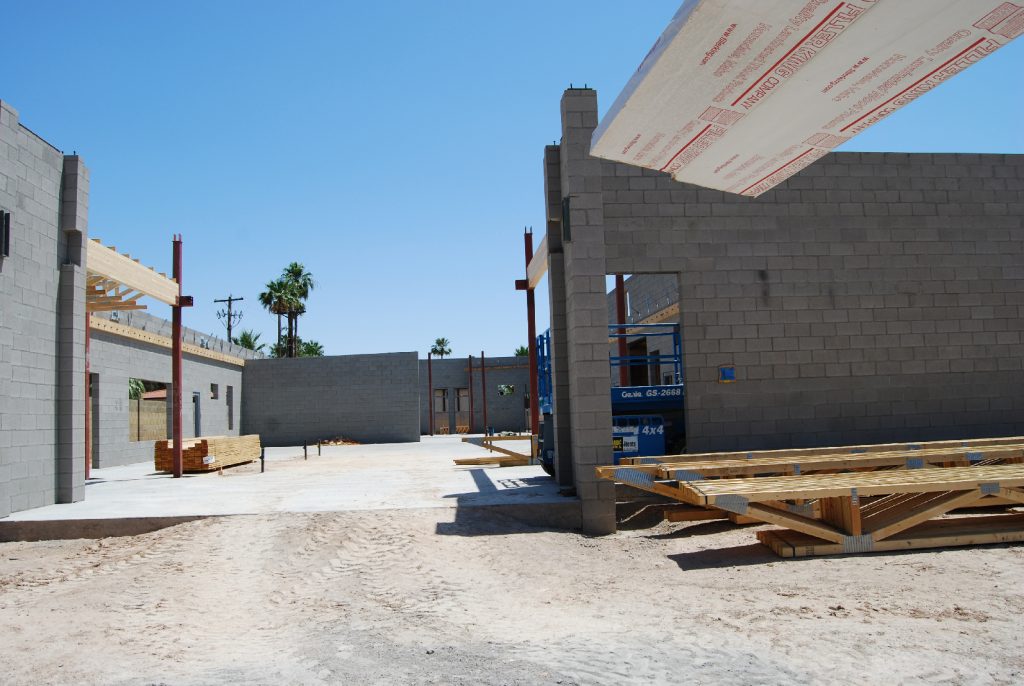
Construction Photo
Summary
When working on a Animal Hospital Design in Arizona, investing in an architect with veterinary building experience will ensure the facility has been built with a design that satisfies your needs, has a good workroom flow, is built of quality materials and falls within a reasonable project budget. Whether it is a tenant improvement or a new building, the process of creating a new Veterinary Facility (Animal Hospital), Grooming Facility or boarding facility can be a rewarding experience.
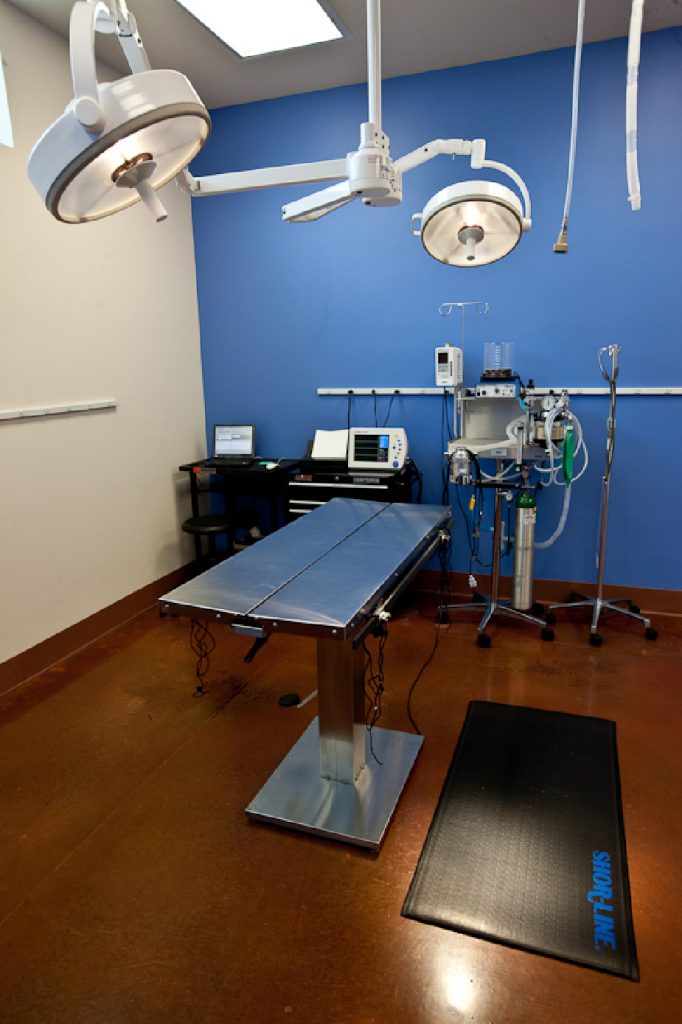
Animal Hospital Design
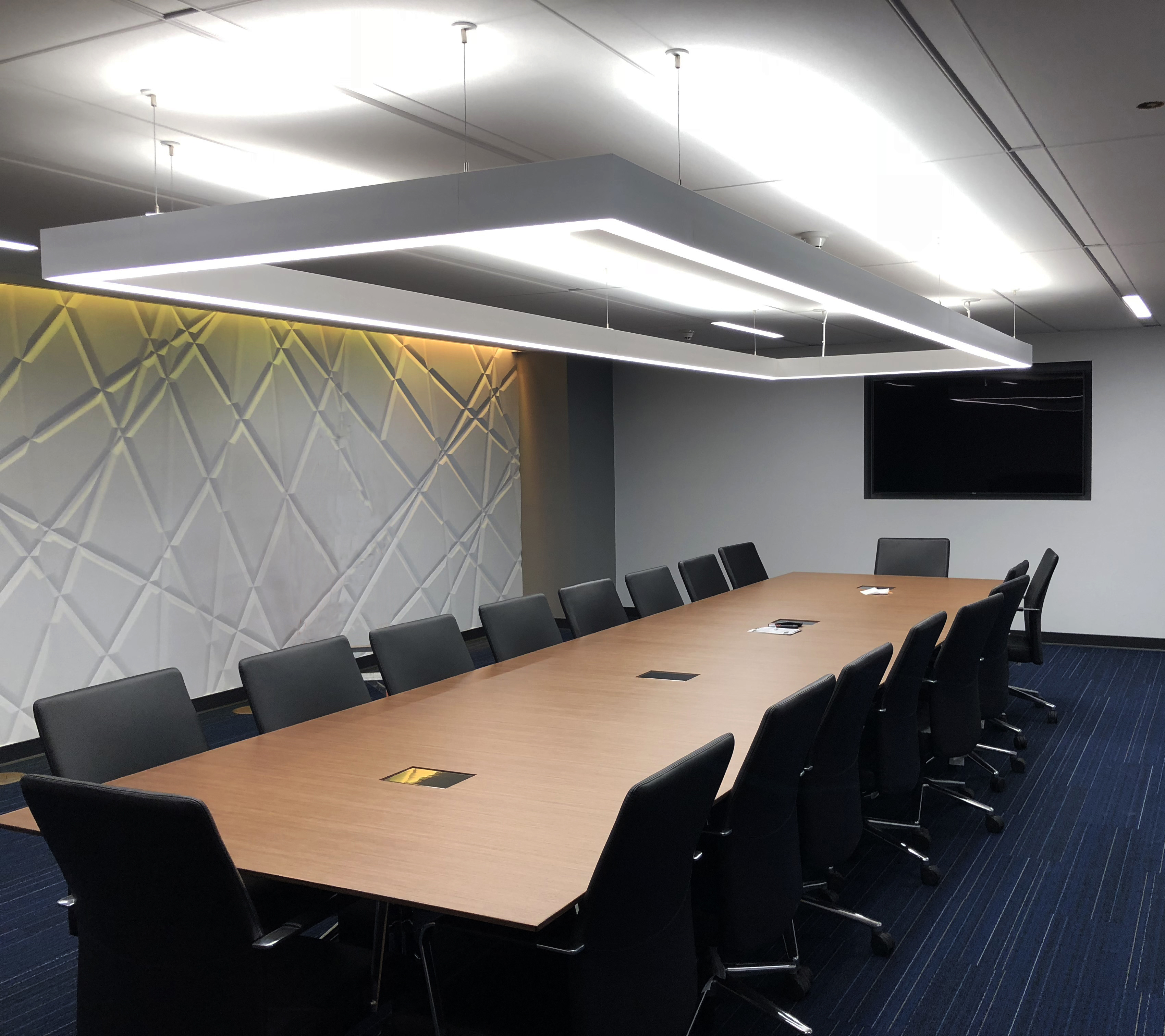
by Jeff Serbin | Jul 12, 2018 | architect in Arizona, Architecture, Blog, Interiors, office architecture, office design arizona, office improvement, phoenix architects, Planning, Uncategorized
Office Architecture in Arizona
When finding an office Architecture in Arizona for rent within existing real estate, some research should be completed before signing a lease. Relying on a Realtor may not provide you with the full spectrum of issues regarding your office improvements. If you are making modifications and doing a tenant improvement, hiring an architect to do this initial research can inform you about potential modifications required by zoning and building code requirements. Even if you are looking at merely changing some finishes, other factors may affect the project scope.
Items to look at:
- Building code of original construction
- Current Building code and its impact upon proposed use
- Type of occupancy at time of construction vs. type of occupancy proposed for your use
- Zoning and intended uses
Because each building and space is unique within office architecture, the architect will need to look at the original set of approved drawings and determine what changes may be required. Changes in occupancy or changes in code can affect the project.
Below is a Case study (example) of a past project. The client initially thought it was mainly going to upgrade some finishes and adding a few walls and doors. However once some research was done, the project scope grew.
Case Study
Project desired scope: Lease approximately 4,000 s.f. office space within existing building with minimal modifications. Upgrade to finishes as needed.
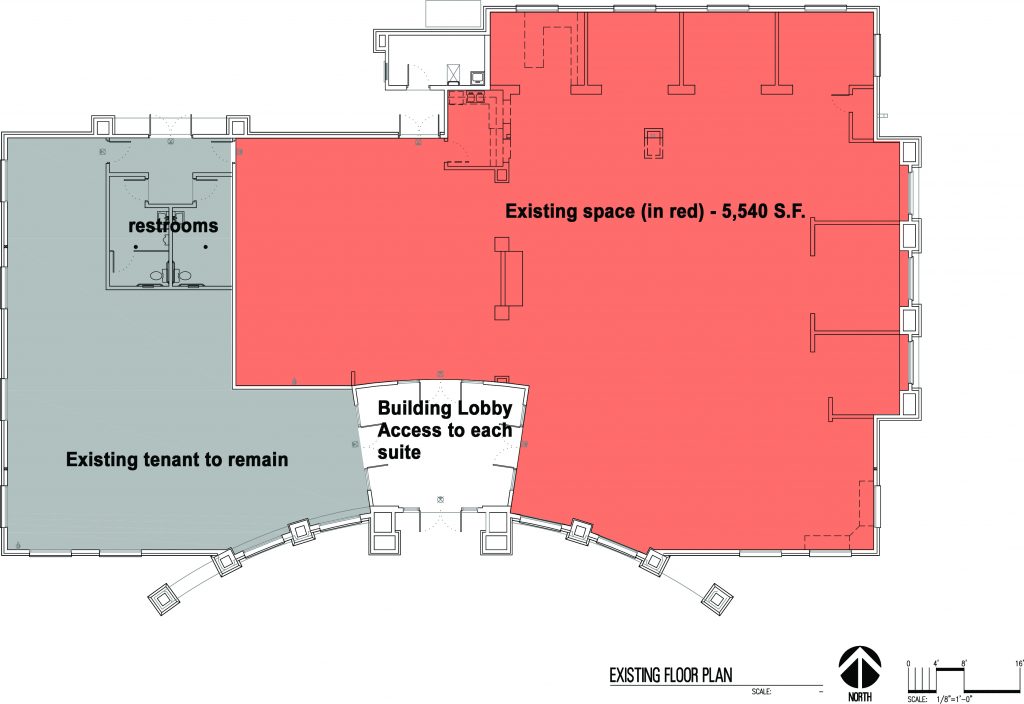
Office Architecture in Arizona – Existing building space available (shown in red)
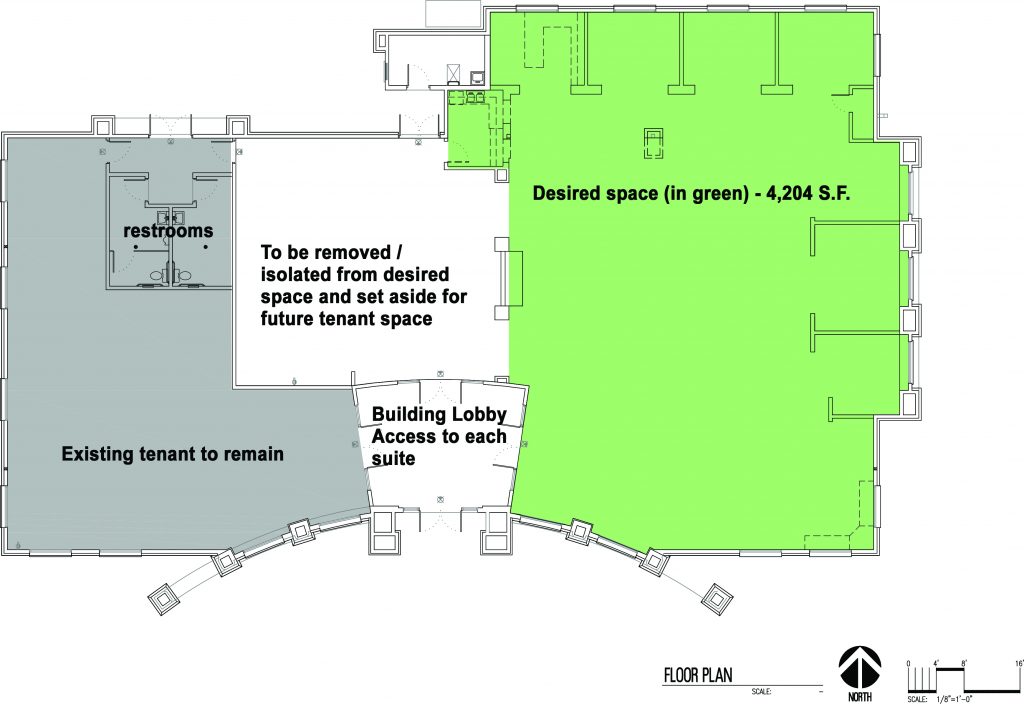
Office Architecture in Arizona – Proposed space (shown in green)
Analysis
The area in green is the desired quantity of space the tenant desired and which sensibly works with the division of the space due to existing walls allowing for a future tenant to be located within the center suite. This allows for each tenant, to remain unaffected, to have accessibility to entry lobby and existing restrooms.
Issues to Address
- Restrooms not accessible to proposed office space unless you travel through middle suite.
- Verify if restrooms (# of fixtures or toilets) meets current codes.
- Potential issue with exiting. # of exits and travel distance to exits will need to be analyzed.
- Determine if mechanical system zones (area the mech unit serve) is not affected by proposed leasable space.
- Determine if electrical systems are distributed properly for a division of the space into 2 separate suites.
- Verify number of parking spaces required/available affected by the proposed modification.
Analysis
It was determined that the existing building, constructed about 25 years ago, was initially designed as a product showroom, not offices. It was initially established as an Occupancy A (Assmebly) Proposed use of the new tenant was to be Occupancy B (Office). Based upon our code analysis, it was determined it had an affect on conflict 2 or quantity of toilets as explained below.
Conflict 1 – Restroom not accessible to space. A corridor was added to allow for access to the existing restrooms while adding a second exit from the space.
Conflict 2 – Verify restrooms meet code. Because Assembly occupancies do not require as many plumbing fixtures than Office space per occupant, the existing quantity of restrooms were adequate in the original use. With the change of occupancy to ‘B’ Office, the # of plumbing fixtures was not adequate. Therefore, one additional toilet stall was added to satisfy codes. (see calculations below). To minimize affecting the original restroom (not affecting its use by existing tenant and affecting existing finishes), it was decided that a 1 person restroom would satisfy the requirement of an additional toilet fixture. This was not a desired addition to scope because of the additional construction cost, but solely to satisfy the building code requirements.
Conflict 3 – Potential issue with existing? The office space as proposed met all exiting requirements. Quantity of occupants did not exceed the number to trigger additional exits. However, because of the accessibility to the restrooms, a second exit was provided.
Conflict 4 – Determine if mechanical system zones need modifications. Because of the original layout, the mechanical zones were not exactly divided into the zones that were established by the new wall creating the future tenant space. Therefore, ductwork modifications and a new mechanical unit was required to allow for the mechanical systems to function properly. This was an unknown addition to the project that the real estate agent would not be able to forsee.
Conflict 5 – Determine if electrical systems are distributed properly. It was determined, not to our surprise, that the electrical systems required separation of power to the 2 suites created. In reality, it could have remained more or less the same but by isolating the power, it allows for the building owner to clearly understand how much power each individual suite utilizes.
Conflict 6 – Is the number of parking spaces required/available affected? Fortunately because the occupant load from Assembly to Office reduced the number of occupants within the space, the number of existing parking spaces were more than adequate. No changes required.
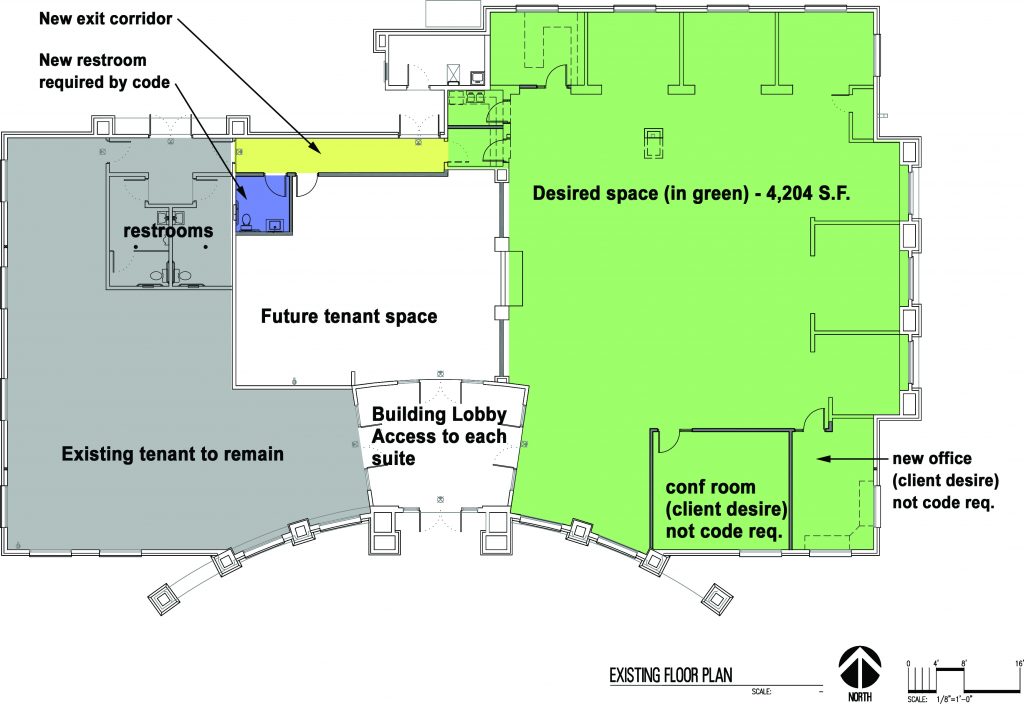
Office Layout
Additional code analysis information
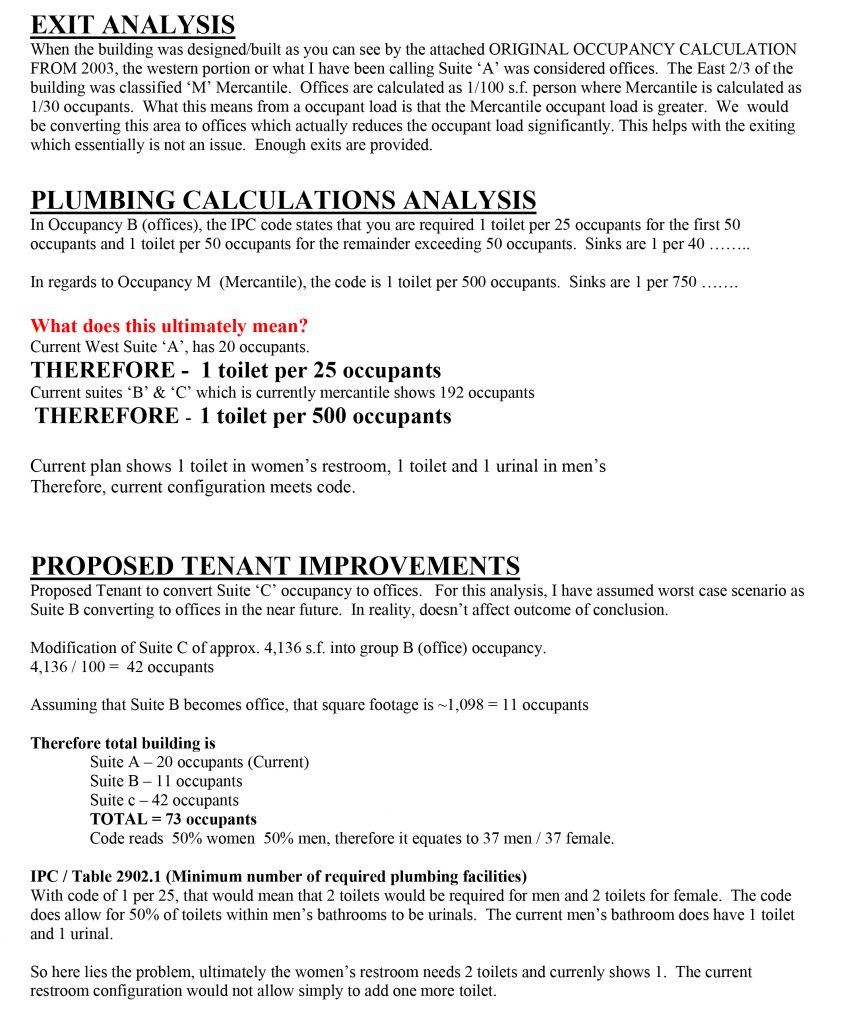
Summary
When finding an office space for rent, even in a simple remodel as shown in the case study, you can see how important research of issues are prior to signing a lease. The analysis will provide you with a more clear understanding of the possible scope due to modifications to the existing building systems, required updates due to current building codes and occupancy changes.
If you are considering an office architecture in the near future, hiring an architect can help you make good choices.

by Jeff Serbin | Jul 9, 2018 | architect in Arizona, Architectural Planning, Architecture, Blog, Collaboration, phoenix architects, Planning, Uncategorized
Looking for an Architect in Arizona?
Finding an architect in Arizona is similar to searching for a good auto mechanic, a veterinarian, a butcher, a banker, etc. Most of the time it is word of mouth if you have someone you can trust. When hiring most services, your relationship with the company or person is important. Architectural projects can last months or years depending on the scale or complexity of a project, therefore that relationship is important. Finding the right Architect in Arizona can be done with the following factors:
- Expertise
- Relationship
- Proximity
- Responsiveness
- Price
Expertise
Architects go through rigorous training in college, learning about history/theory of architecture, design/communication, technologies, practice/management, community design, preservation and all aspects of design. Therefore, an architect has an ability to obtain knowledge for any design challenge. Architects generally specialize in either residential or commercial. Even though some architects work in both arenas, most lean towards one. Many architects start in residential architecture getting their feet wet and later design commercial buildings only.
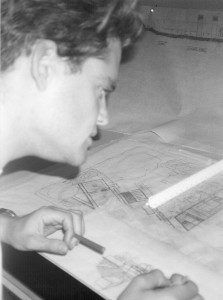
University life as an architect – Serbin
In the residential arena, architects may specialize in single family homes vs. multi-family or apartments. In commercial architecture, an architect may become an expert in a specific type of building such as: educational, office buildings, laboratories, warehouse, manufacturing, data center etc.
When finding an architect, ask them about their expertise to determine if their experience may fit your project type. However, as previous mentioned, an architects training teaches them to gather knowledge on any project, allowing them to truly handle most projects. Ask most architects, and they will confess they can design any type of building.
Architecture is truly a team approach. An architects role is to put together a team of designers and engineers qualified for the type of project. Therefore, even if the architect itself doesn’t have the type of building on their resume, the teams gathered experiences will allow for a successful project.
Relationship
Architecture can be a long process lasting months, even years. For some clients, it may be a one time project and the relationship short. Some clients have ongoing multiple projects which will foster a relationship that lasts for years. Nevertheless, the relationship between the architect and client is important. Getting along with the architect can somewhat be like a marriage. First is the courtship to determine if you have similar likes/dislikes (styles of architecture and expertise). Second, is the architect committed to the relationship to assist the client with their goals and aspirations (dedicated to making the building satisfy their needs). Third, once the honeymoon is over and the project is underway, can the relationship get through the challenges and struggles of the design and construction process. Can you communicate your likes and dislikes of the design and talk about money and project budget?

Relationship and Trust
Proximity
Architecture is a contextual art. Buildings are designed to relate to the environment. Architects must understand the general weather, solar aspects and orientation, site irregularities and natural disturbances from weather and even earthquakes. Since an architect, gathers knowledge on any project, proximity to the project is slightly less important. An Architect in Arizona must be registered within the State the project is located. However, hiring an architect for a desert climate like Arizona, one wouldn’t want to hire an architect who designs solely for the tropics.
When hiring local, someone from one side of town to the other, can have little effect upon a project. So finding an architect anywhere within your metropolitan area or even your state should be adequate. Most likely, the architect will travel to you to make the project easier.
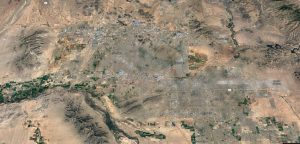
Proximity of Architect in Arizona
Responsiveness
Timely design is important to getting a project completed. First step is to hire a responsive architect, one who can educate that client on the process process to complete your project. The architect must determine the necessary steps to getting a permit and oversee the construction. Each site requires various approvals from local governing jurisdictions.
A time frame should be established for all the steps involved in the project. From zoning, design reviews, site plan reviews, building plan reviews to general construction durations, establishing a realistic time frame, with some wiggle room, is important. This will allow you to communicate to the architect your concerns if time feels like it’s slipping away.

Just like running track, you can’t wait around if you want to finish
Price
Design services can vary depending upon the complexity of the project. The architect is like the ringleader of a circus. They must gather up the necessary performers (ie. engineers) to allow for a successful show. Some projects may require specialists to ensure a proper design. A required, recommended and desired team of engineers could significantly affect the overall design fee.
List of potential engineers (as needed)
- Mechanical Engineer
- Plumbing Engineer
- Electrical engineer
- Structural Engineer
- Soils engineer
- Civil Engineer
- Security consultant
- Lighting consultant
- Acoustical consultant
- Landscape architect
- Utility Design consultant
Typical architectural fees for commercial projects vary, however ~8% of construction may be reasonable. However project types and overall construction costs factor into the percentage. Higher rates may occur due to complexity of the project. In general, the greater the construction cost, the lower the % fee. When an architect deals with a smaller project, the percentage is typically higher because of the basic tasks an architect must perform for any project. Typically I like to refer to “economies of scale”. If working on a renovation to an existing facility, hiring the original design team or even getting a hold of the original design documents can affect the overall design fees. Hiring an Architect in Arizona vs. outside the state will also save you time and money since the team doesn’t have to consider travel expenses and time within their fees.

Architects fee is worth every penny
Summary
Hiring the right architect is important for a successful project. One may hire an architect based upon seeing a completed building, word of mouth from a trusted colleague or a simple internet search. However factors such as expertise, relationship, Proximity, responsiveness and price factor into that selection. An architects expertise or ability to put together a team can create a successful project. Building the relationship with an architect can allow for trust. Proximity of the architect to the job site or more importantly, understanding the local area and governing jurisdiction is important for a well designed building. Responsiveness is important for a timely delivery. Architects design fee are important to allow for the project to fall within the project budget. Good luck!
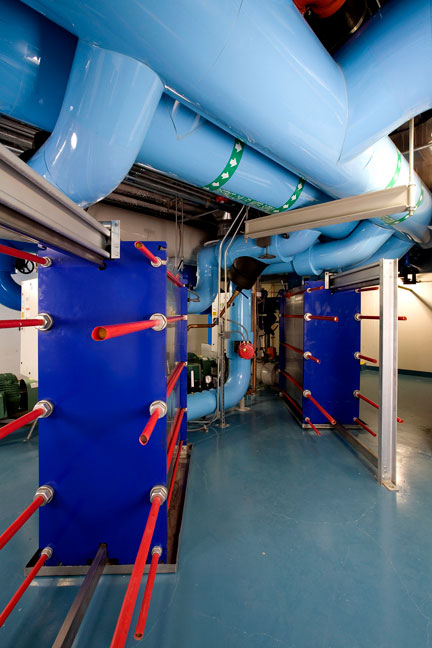
by Jeff Serbin | Apr 25, 2018 | Architecture, Blog, colocation, Colocation Data Center, Data Center Design, Data Center Design firms, Data Hall, Interiors, phoenix architects, Uncategorized
Data center’s are used to house computers which store information.
The information is stored away for ongoing importing and exporting of information, long term safekeeping and storage for future retrieval. Because the majority of this information is “for your eyes only”, the environment has to be secure from others and available to you whenever you desire it.
The information stored varies from personal to business. Banks store financial information, companies store information relating to their business, Facebook has your photos and posts, Twitter holds on to your tweets, Amazon stores your past orders, Apple Icloud stores your photos, your online retailer stores your credit card numbers, your kids snapchat floats in the cloud, this post is stored there etc.
Most people don’t realize where this information really goes or where it is stored. The term ‘cloud’ makes you look up in the sky, like a scene from Avatar, but it is all rooted firmly on the ground in Data Centers.
A Data Center therefore must be a highly secure environment which allows for oneself to access that information on a moments notice. For the most part, it is instantaneous. There are two main scenarios. (1) A company can build and operate their own data center or (2) rent space, called a colocation Data Center. Colocations Data Centers manage the facility, similar to renting space within an office building. The rental of space may be as small as one computer server, a rack which may store a dozen computers, a cage of any size storing 100’s of computers or a room storing thousands of computers. The top 4 Wholesale colocation Data Center providers as recognized by Data Center Knowledge are
- Digital Realty
- Global Switch
- CyrusOne
- China Telecom
The typical data center is comprised of a large room anywhere from a few thousand feet upwards to 40,000 s.f. The room is supported by a large electrical and mechanical infrastructure to maintain power to the computer servers while keeping them at a desired temperature. Computers use energy which give off a lot of heat. This heat if not removed will build up in a room which eventually will shut down the servers.
The power consumption within a Data Center is similar to how one uses power within our homes. At times, you have peak power when everyone is at home, turning on lights, cooking something in the oven, running our A/C to keep ourselves cool while watching television show. At other times, your power consumption is low, when your not home or asleep at night. Power companies need to supply enough power to handle the peak times a Data Center has when its servers are in heavy demand or else outages occur and clients are not happy. Therefore, data centers are similarly designed to handle higher than expected use so they can ensure that any demand is met. Data Centers use approximately 4% of the energy consumption within the U.S.
The quantity of Data Center is surprising. There are 40+ colocation Data Centers within Arizona and 100’s of privately run Data Centers.
Serbin Studio has been specializing in Data Center Design since 2004. The data center building is usually inconspicuous, not one to stand out and draw attention to. They have a level of secrecy so they can float under the radar. Most projects require the designers to sign a Non-disclosure agreement so the secrecy of the design methods are not shared with the competitors.
Within that 14 year period, we have worked on over 300 data center projects relating to conceptual designs, data center renovations, commercial office renovations, elevator renovations, exterior facades etc.
Our most recent projects in 2018 which I have sworn to secrecy include:
- Master planning for a new facility
- Exterior renovations to enhance an existing facilities tired facade
- Lobby, Customer lounge, restroom, offices and conference room renovations to enhance the customer experience
- Power upgrades to an existing facility




















